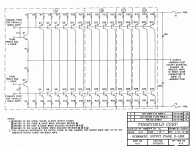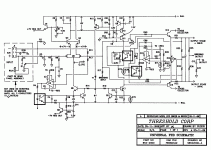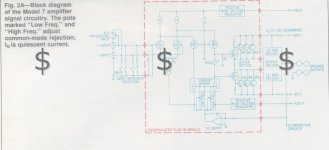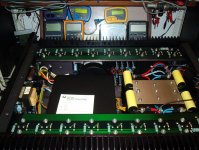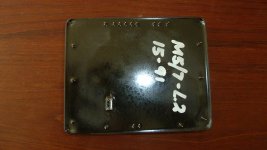Dear DIY's,
I have a pair of Threshold SA/1's with a non optical bias front end.
I already substituded the large blue Mallory's for new ones.
How do these amps compare to the last 'e' series like a SA/4e?
The frontend on my amps are the 1983/84 Series II type.
I know that the optical bias was incorporated to get a stable bias that would not fluctuate when other variables like temp changed.
I know both Series use the Stasis technique but I wonder how much the newer frontend boards do affect the sound.
Thanks
I have a pair of Threshold SA/1's with a non optical bias front end.
I already substituded the large blue Mallory's for new ones.
How do these amps compare to the last 'e' series like a SA/4e?
The frontend on my amps are the 1983/84 Series II type.
I know that the optical bias was incorporated to get a stable bias that would not fluctuate when other variables like temp changed.
I know both Series use the Stasis technique but I wonder how much the newer frontend boards do affect the sound.
Thanks
Dear Mr. Pass,The SA1's have more hardware and bias for each channel -
they would get the nod.

Thanks for your swift answer.
I deduce that the differences in the frontboards are of minor importance compared to the differences in heatsink surface area (more dissipating power in the SA/1's therefore more bias allowed), powersupply and number of outputdevices.
I also reckon that the fundamental circuittopology in the S an SA Series from 1983 till 1990 stayed the same.
Thanks for the reactions.
But apart from the hardware differences:
SA\4e: 2 x 800 Watts Toroids, 186,000 uF, 52 TO3 Outputdevices
vs
SA\1: 2 x 1000 Watts Toroids, 236,000 uF 80 TO3 Outputdevices
that would certainly be in favor of the SA/1 mono's.
I wonder if the last incorporated frontend in the so called 'e' class of amps (SA/3.9 - SA/12) is much superior then the first Stasis offerings in the SA class of amps.
Or had those improvements over those 9 years mainly to do with achieving a stable parameters in areas like bias, temperature and DC values?
For the sake of the discussion would you still prefer the SA/1 over let say a XA-30.5 just because the former has definitely more hardware?
Let's pressume here that both amps do not have to drive an Apogee Scintilla or produce eardeafening levels of SPL.
I'm trying to determine here what is the principal factor that will have the most influence on the way the amps "sounds". I was under the impression that the circuittopology used on the frontendboards is the most determining factor presuming that it has a proper designed and stiff powersupply and the powertransistors have enough Class A enrichment to keep them in their linear regions for 90% of the amps powerrating.
The differences in hardware between the SA/4e (the biggest stereo-amp Threshold produced) are not that big, but they do have different frontend boards though.
But apart from the hardware differences:
SA\4e: 2 x 800 Watts Toroids, 186,000 uF, 52 TO3 Outputdevices
vs
SA\1: 2 x 1000 Watts Toroids, 236,000 uF 80 TO3 Outputdevices
that would certainly be in favor of the SA/1 mono's.
I wonder if the last incorporated frontend in the so called 'e' class of amps (SA/3.9 - SA/12) is much superior then the first Stasis offerings in the SA class of amps.
Or had those improvements over those 9 years mainly to do with achieving a stable parameters in areas like bias, temperature and DC values?
For the sake of the discussion would you still prefer the SA/1 over let say a XA-30.5 just because the former has definitely more hardware?
Let's pressume here that both amps do not have to drive an Apogee Scintilla or produce eardeafening levels of SPL.
I'm trying to determine here what is the principal factor that will have the most influence on the way the amps "sounds". I was under the impression that the circuittopology used on the frontendboards is the most determining factor presuming that it has a proper designed and stiff powersupply and the powertransistors have enough Class A enrichment to keep them in their linear regions for 90% of the amps powerrating.
The differences in hardware between the SA/4e (the biggest stereo-amp Threshold produced) are not that big, but they do have different frontend boards though.
Speaking about hardware:
Just bought a pair of Jeff Rowland Model 7 Latest Series (transimpedance I believe).
Having read J. Gordon Holt's very favorable review of the Threshold SA/1 in Stereophile (Vol. 9, NO. 1, Feb. 1986, got the reprint as salesliterature from Threshold Corp. in 1987 self) where Holt states that: "Sonically, this is one of the most gorgeous power amps I've heard! Highs are silky-sweet and open, with a naturalness equalled only by the Rowland 7's (which just happen to cost about the same amount -for 200 Watts/ch).
The model 7 is according to Jeff Rowland a succesor of the Rowland WL-500 (WL standing for West Labs. beiing in effect Roger West the owner/designer of SoundLab electrostatics. Jeff Rowland specially made on his request a highpower amp for those difficult loads.
J. Gordon Holt used SA/1's on his SoundLab A1's but stopped because he found the optical bias update a lesser match with his SoundLabs then the old one.
I'm very curious who these two masterpieces (I think there's intersubjectivity in the audio-community that those amps are both Nelson Pass and Jeff Rowland finest although I'm not claiming that they are in fact) compare to eachother.
Gordon Holt found them very similar so there's a starting point...
Just bought a pair of Jeff Rowland Model 7 Latest Series (transimpedance I believe).
Having read J. Gordon Holt's very favorable review of the Threshold SA/1 in Stereophile (Vol. 9, NO. 1, Feb. 1986, got the reprint as salesliterature from Threshold Corp. in 1987 self) where Holt states that: "Sonically, this is one of the most gorgeous power amps I've heard! Highs are silky-sweet and open, with a naturalness equalled only by the Rowland 7's (which just happen to cost about the same amount -for 200 Watts/ch).
The model 7 is according to Jeff Rowland a succesor of the Rowland WL-500 (WL standing for West Labs. beiing in effect Roger West the owner/designer of SoundLab electrostatics. Jeff Rowland specially made on his request a highpower amp for those difficult loads.
J. Gordon Holt used SA/1's on his SoundLab A1's but stopped because he found the optical bias update a lesser match with his SoundLabs then the old one.
I'm very curious who these two masterpieces (I think there's intersubjectivity in the audio-community that those amps are both Nelson Pass and Jeff Rowland finest although I'm not claiming that they are in fact) compare to eachother.
Gordon Holt found them very similar so there's a starting point...
After playing for a week now with the JRDG model 7 I come to the following conclusions:
To play the complete musical scala offered you need them both.
First let me say this: For a design that dates back to the end of the Seventies the SA/1 is a (still) very good amplifier. With rock and large scale symphonic work I definitely prefer the SA/1 over the Model 7 who's just too polite with this kind of material. With the better popmusic from Suzanna Vega, Ricky Lee Jones and Nick Drake the model 7 is clearly superior.
I performed some standard work on the model 7 like rewiring the torodials for 240 Volts, lowering the input impedence to 600 Ohm and gain factor from 26 tot 20 dB (on the back of the epoxy encapsulated frontend module). DC and bias were no issue, just checked them and they were fine. DC < 10 mV and a biassetting allowing 60 Watts Class A peak and 30 Watts RMS.
Fit and finish in- and outside were superb. I've seen a lot of gear from Levinson, Krell etc .. but Rowland is clearly the best when it comes to the construction of the amp.
I've read 7 or so reviews from TAS, Stereophile, Hifi News and Recordreview and they all state that the model 7 has no negative feedback at all. That is not overall or nested.
It's stated that due the lack of NFB he has to compensate this with a huge powersupply.
Can somebody explain that to me?
To play the complete musical scala offered you need them both.
First let me say this: For a design that dates back to the end of the Seventies the SA/1 is a (still) very good amplifier. With rock and large scale symphonic work I definitely prefer the SA/1 over the Model 7 who's just too polite with this kind of material. With the better popmusic from Suzanna Vega, Ricky Lee Jones and Nick Drake the model 7 is clearly superior.
I performed some standard work on the model 7 like rewiring the torodials for 240 Volts, lowering the input impedence to 600 Ohm and gain factor from 26 tot 20 dB (on the back of the epoxy encapsulated frontend module). DC and bias were no issue, just checked them and they were fine. DC < 10 mV and a biassetting allowing 60 Watts Class A peak and 30 Watts RMS.
Fit and finish in- and outside were superb. I've seen a lot of gear from Levinson, Krell etc .. but Rowland is clearly the best when it comes to the construction of the amp.
I've read 7 or so reviews from TAS, Stereophile, Hifi News and Recordreview and they all state that the model 7 has no negative feedback at all. That is not overall or nested.
It's stated that due the lack of NFB he has to compensate this with a huge powersupply.
Can somebody explain that to me?
I know that one specific designfeature solely doesn't create the perfect tool. But I wondered if it is even possible to design a completely feedbackless amplifier as almost all the reviewers state and how this relates, if this feature of total NFB does exist, with needing a huge powersupply to compensate the lack of it.That an amplifier has no negative feedback whatsoever
is an interesting factoid, but it doesn't guarantee that it will
sound good.

I supplied a scan of the simplified schematic published in the Audio Magazine of April 1990 page 58.
Attachments
That's what the experts say:No feedback ?
Anthony Cordesman in TAS Vol. 14 Issue 58 page 89:
"Rowland takes it to the limits what simplicity can accomplish. For example, only one transconductance device is used for the gain in most stages; there is direct coupling throughout; and there is zero negative feedback."
Lewis Lipnick in Stereophile Vol. 11 No.7 page 85:
"The Model 7, just as with all of Jeff Rowland's designs, utilizes no feedback, nested or global."
Ken Kessler in Hifi News & Record Review, March 1989 No.2:
"A solid-state unit, the Model 7 is absolutely feedback free, Rowland preferring
to compensate for its absence with an overkill power supply not requiring the benefits of negative feedback;...
"Most important of all, according to Rowland, is that absence of nested and overall feedback eliminates time domain distortion; the amplifier employs proprietary techniques to minimize distortion in the amplitude domain."
Brochure of the JRDG line up under 'Product Highlights':
"Zero negative feedback"
Those are two respected American highend audio periodicals and one English stipulating just that.
According to the quotes taken from Ken Kessler's review in Hifi News & Record Review even Jeff Rowland himself claims that there is zero feedback.
But I'm really interested in what both Ken Kessler says about the compensating massive powersupply and Anthony Cordesman says further on in his review:
"They (he ment the Coherence One preamp and the Model 7) do not use feedback because of what Rowland calls 'time related distortions', and use high performance power supplies to compensate for this lack of feedback."
I'm interested in that mechanism because I do not understand this relation.
I supplied a scan of the simplified schematic published in the Audio Magazine of April 1990 page 58.
Hi BrianEno.
Thanks for sharing the schematic, I have been working in Jeff Rouland Model 5, and wondering what must be inside the encapsulated capsules...
Attachments
when reviewers say "no feedback", they almost always mean "no global feedback" or no feedback across more than one stage.
the simplified rowland schematic showed earlier cannot be truly "no feedback" with a dc servo as well as the usual bias controller.
mlloyd1
Yes I know but here we have Cordesman, Lipnick and Kessler from three different Anglosaxon leading audio-magazins that specifically say that there is no feedback at all in the Model 7's.
Lipnick says: "The Model 7, just as with all of Jeff Rowland's designs, utilizes no feedback, nested or global." Well that's not multi-interpretable it seems to me.
But as already stated I'm really interested how the mechanism works of having a huge powersupply to countereffect the absence of NFB?
It's only a simplified schematic according to the reviewer of Audio.Thanks for sharing the schematic, I have been working in Jeff Rouland Model 5, and wondering what must be inside the encapsulated capsules
You probaly need a X-Ray machine to see at all cause Jeff won't share it with you.
On his new site under 'Schematic policy': "All Jeff Rowland Design Group product schematics are proprietary and as such are not available for distribution."
I made a picture of the back of that module and there you can see how to alter the gainsetting from 20 to 32 dB.
20 dB is all connections removed.
26 dB as in the picture shown the factory default.
29.5 dB connector to the other site.
32 dB both connected.
I removed all connections to match it with my Krell KRC preamp.
According to Rowland this operation had to be performed by a authorized dealer because of the risk to bend one of the 19 pins.
Mirror, mirror on the wall is my amp the prettiest of them all?anyway - now is perfect time - that you draw schm of da thing , and share with us
Please Zen Mod share with us your opinion about this amp and tell us why a huge powersupply is neede to compensate the lack of feedback.
Attachments
Just adding to the above Reply:
Even my Owners Manual states on the first line under 'Features':
"Lack of overall or nested negative feedback eliminates time domain distortion."
So that's Jeff Rowland self telling you that his design has no feedback at all.
That's where the reviewers probably got it from because they're to lazy to verify such a statement or not bright enough (like me!) as you are to refute such a claim ;-)
Even my Owners Manual states on the first line under 'Features':
"Lack of overall or nested negative feedback eliminates time domain distortion."
So that's Jeff Rowland self telling you that his design has no feedback at all.
That's where the reviewers probably got it from because they're to lazy to verify such a statement or not bright enough (like me!) as you are to refute such a claim ;-)
- Status
- This old topic is closed. If you want to reopen this topic, contact a moderator using the "Report Post" button.
- Home
- Amplifiers
- Pass Labs
- Threshold SA/4e vs SA/1
